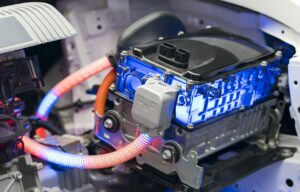
Markets and Applications
Just as differentiated as the areas of application are, so are the markets!
Commercially launched as a product by Sony in 1991 to power consumer electronics, the technology has since evolved. In recent years, lithium-ion battery technology is finding its way stepwise into a variety of applications such as electric cars, electric aircrafts, drones, or applications with even more stringent requirements such as those used in mining, drilling or medical applications. Each application places different demands on the battery. Due to the different materials used, not all requirements can be met by one universal battery setup. Therefore, an adjustment of the battery is required to address each application with maximum efficiency. In this regard, the development of tailor-made electrolytes is a key strategy for success. We are ready to accompany this development in the best possible way and to optimally adjust our customers’ products to the specific market with customized electrolytes.
Application fields of tailor-made electrolytes
High energy cells
With the application of advanced electrode materials, such as silicon at the anode side, unconventional electrolyte solutions are mandatory in order to enable these technologies. Only with the utilization of electrolytes adapted by new choices of electrolyte solvents and/or additives, advanced lithium-ion cells with increased energy density will be able to keep up with conventional graphite-based cells in terms of cycle life.


High- und deep temperature applications
The application range of lithium-ion cells is currently very much limited in the temperature range due to the use of standard electrolyte mixtures. Normally between 0 and +55 °C during charge and –20 and +60 °C during discharge. With the clever selection of either electrolyte solvent mixtures, Li-salt blends and/or additive combinations, the range of temperature can be broadened or moved towards either the low or high temperature range.
High voltage applications
Current state-of-the-art electrolytes lack electrochemical stability towards high voltage electrode materials, which is especially of interest in the development of cobalt-free cathode active materials and/or increasing the operating voltage of state-of-the-art cathode active materials such as NMC. By skillful adaption of either electrolyte solvent mixtures, Li-salt blends and/or additive combinations the compatibility of electrolytes within lithium-ion batteries using increased cut-off voltages can be achieved.


High power applications
Fast Li+-ion transport through the liquid phase, but also through the interphases is essential for current and future high-power applications with e.g. fast charging capability. Therefore, the Li+-ion transport properties within the electrolyte must be adapted by a smart choice of the right electrolyte solvent mixtures, Li+-ions salt mixtures and/or additive combinations in order to meet these requirements while ensuring a long battery life of the battery.
New cell chemistries
New technologies, such as e.g. electric flying, require the application of so-called next-generation technologies, such as lithium-sulfur, as gravimetric energy rather than volumetric energy density is more important. These technologies also require a highly optimized electrolyte, which can differ in its composition from that of classical lithium-ion technology in the solvents, lithium-salts and additive combination used.


High safety
Some applications require increased intrinsic safety properties. Examples are medical and large scale stationary energy storage systems or maritime and mining applications. The electrolyte plays a crucial role in order to meet the requirements. The safety properties of lithium-ion cells can be optimized by the appropriate choice of solvent and co-solvent mixtures, lithium salt or mixtures and safety additives such as flame retardants or shutdown additives. Ideally, battery life and performance is not affected.


